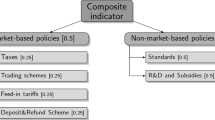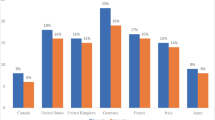Abstract
Using panel data, we find evidence for significant direct and indirect effects of trade on carbon emissions. Trade tends to increase the emissions burden, especially in those less industrialized countries. We also find evidence for a U-shaped relationship between income per capita and carbon emissions. We discuss the effectiveness of emission reduction policies in light of these results and advance some proposals to reconcile environmental and trade policymaking.
A partir de données de panel, nous constatons que le commerce a des effets directs et indirects significatifs sur les émissions de carbone. Le commerce tend à accroître la charge des émissions, particulièrement dans les pays moins industrialisés. Les données mettent également en évidence une relation en forme de U entre le revenu par habitant et les émissions de carbone. Au vu de ces résultats, nous évaluons l’efficacité des politiques de réduction des émissions et formulons des propositions pour concilier l’élaboration des politiques commerciales et celle des politiques environnementales

Similar content being viewed by others
Notes
The UNFCCC negotiations’ current mandate coming from the Bali 2007 COP has a double track: (i) an LCA track to come up with ways to enhance the full implementation of the UNFCCC, and (ii) a Kyoto Protocol track in which a second commitment period, and with a new aggregate emission reduction target (for developed countries), should be negotiated. The G77 is currently insisting that this mandate must be kept, while developed countries would rather scrap the second track by merging negotiations of their emission reduction targets (coming from Copenhagen and now reflected in their Cancun pledges) with the negotiations on developing country climate change actions.
In their seminal contribution, Grossman and Krueger (1993) estimate that SO2 pollution peaks at a per capita income level between $5000 and $6000. Other scholars find similar figures for carbon monoxide (see Selden and Song, 1994; Frankel, 2008).
An important caveat applies to this mechanism: if politics matters in this process, popular demand for higher environmental quality will only materialize into effective regulation if and only if appropriate representative institutions are in place (Payne, 1995).
See also Frankel (2008).
In March 2009, testifying at a hearing in the US House of Representatives, John McMackin on behalf of the Energy-Intensive Manufacturers’ Working Group explicitly threatened delocalization of production overseas: ‘If the United States enacts tough global warming regulation but other key manufacturing nations do not, production of energy-intensive goods may well shift to the unregulated countries’.
The political influence of the high-polluting industries is, of course, a key factor.
Yang and Yang (2010) emphasize that those ‘who consume goods […] should also share the responsibility’ and pay for the relevant reductions, and they recommend China to ‘claim a consumption based accounting system’ in the global climate negotiations.
There has been much warning of the threat of public investment crowding out private investment. Crowding out, strictly speaking, refers to the variety of channels whereby additional government spending may have little or even a negative effect on total output because of its adverse effects on interest-sensitive components of private expenditure. Neither theory nor empirical evidence provides a basis for clear-cut conclusions in these respects (Everhart and Sumlinski, 2001, Table 2.2).
Table 4.3 of Rodrik (2007) shows how restrictions are defined under each institution or agreement and under what conditions they apply.
Least developed countries and developing countries with less than $1000 per capita gross national product are exempted from rules on subsidies under the Agreement on Subsidies and Countervailing Measures.
References
Aichele, R. and Felbermayr, G. (2010) Kyoto and the carbon content of trade. FZID Discussion Papers 10-2010, University of Hohenheim, Center for Research on Innovation and Services.
Anderson, K. (1992) The standard welfare economics of policies affecting trade and the environment. In: K. Anderson and R. Blackhurst (eds.) The Greening of World Trade Issues. Ann Arbor, MI: University of Michigan Press, pp. 25–48.
Anderson, K. (1998) Environmental and labor standards: What role for the WTO? In: A.O. Krueger (ed.) The WTO as an International Organization. Chicago, IL: University of Chicago Press, pp. 231–255.
Babiker, M.H. (2005) Climate change policy, market structure, and carbon leakage. Journal of International Economics 65 (2): 421–445.
Barrett, S. (1997) The strategy of trade sanctions in international environmental agreements. Resource and Energy Economics 19 (4): 345–361.
Barrett, S. (2000) Trade and environment: Local versus multilateral reforms. Environment and Development Economics 5 (4): 349–359.
Baumol, W.J. and Oates, W.E. (1988) The Theory of Environmental Policy. Cambridge, US: Cambridge University Press.
Bhandarkar, M. and Alvarez-Rivero, T. (2008) From supply chains to value chains: A spotlight on CSR. In: D. O’Connor and M. Kjollerstrom (eds.) Industrial Development for the 21st Century. London: Zed Books.
Burniaux, J.M. and Martins, J.O. (2000) Carbon Emission Leakages: A General Equilibrium View. OECD Economics Department Working Papers 242.
Carraro, C. and Massetti, E. (2011) Beyond Copenhagen: A realistic climate policy in a fragmented world. Climatic Change 110 (3): 523–542.
Cervellati, M. and Fortunato, P. (2011) Resistance to reforms, inequality and development. Unpublished manuscript, University of Bologna.
Chichilnisky, G. (1994) North–South trade and the global environment. American Economic Review 84 (5): 851–875.
Clapp, J. and Dauvergne, P. (2005) Paths to a Green World: The Political Economy of the Global Environment. Cambridge, MA: MIT Press.
Dasgupta, S., Laplante, B., Wang, H. and Wheeler, D. (2002) Confronting the environmental Kuznets curve. Journal of Economic Perspectives 16 (2): 147–168.
Dua, A. and Esty, D.C. (1997) Sustaining the Asia Pacific Miracle: Environmental Protection and Economic Integration. Washington DC: Institute for International Economics.
Ederington, J. and Minier, J. (2002) Is environmental policy a secondary trade barrier? An empirical analysis. Canadian Journal of Economics 36 (1): 137–154.
Esty, D.C. (1994) Greening the GATT: Trade, Environment and the Future. Washington DC: Institute for International Economics.
Esty, D.C. (2001) Bridging the trade–environment divide. Journal of Economic Perspectives 15 (3): 113–130.
Esty, D.C. and Giradin, D. (1998) Environmental protection and international competitiveness: A conceptual framework. Journal of World Trade 32 (3): 5–46.
Esty, D.C. and Ivanova, M. (2004) Globalization and Environmental Protection: A Global Governance Perspective. Yale Center for Environmental Law and Policy Working Paper 0402.
Everhart, S.S. and Sumlinski, M.A. (2001) Trends in Private Investment in Developing Countries: Statistics for 1970–2000 and the Impact on Private Investment of Corruption and the Quality of Public Investment. Washington DC: World Bank. International Finance Corporation Discussion Paper no. 44.
Frankel, J.A. (2008) Global Environmental Policy and Global Trade Policy. Harvard Kennedy School Discussion Paper 08–14.
Frankel, J.A. and Rose, A.K. (2005) Is trade good or bad for the environment? Sorting out the causality. The Review of Economics and Statistics 87 (1): 85–91.
Gallagher, K.P. (2008) Foreign direct investment and clean technology leapfrogging in China. In: K.P. Gallagher (ed.) Handbook on Trade and Environment. Cheltenham, UK: Edward Elgar, pp. 147–155.
Goldemberg, J. (1998) Leapfrogging energy technologies. Energy Policy 2 (10): 729–741.
Grossman, G. and Krueger, A. (1993) Environmental impacts of a North American free trade agreement. In: P. Garber (ed.) The U.S.–Mexico Free Trade Agreement. Cambridge, MA: MIT Press.
Gupta, S. and Tirpak, D.A. (2007) Chapter 13: Policies, Instruments and Co-operative Arrangements. Geneva, Switzerland: In IPCC Fourth Assessment Report, Working Group III, Mitigation. IPCC.
Helm, D. (2008) Climate-change policy: Why has so little been achieved? Oxford Review of Economic Policy 24 (2): 211–238.
Helm, D. and Hepburn, C. (2007) Carbon contracts. In: D. Helm (ed.) The New Energy Paradigm. Oxford, UK: Oxford University Press, pp. 63–75.
International Panel on Climate Change. (2001) IPCC Third Assessment Report – Climate Change 2001.
Khor, M. (2009) Copenhagen: Key Issues Facing Developing Countries. Geneva, Switzerland: South Centre.
Kozul-Wright, R. and Rayment, P. (2007) The Resistible Rise of Market Fundamentalism: Rethinking Development Policy in an Unbalanced World. London: Zed Books.
Lopez, R. (1994) The environment as a factor of production: The effects of economic growth and trade liberalization. Journal of Environmental Economics and Management 27 (2): 163–184.
Mattoo, A., Subramanian, A., van der Mensbrugghe, D. and He, J. (2009) Reconciling Climate Change and Trade Policy. Centre for Global Development Working Paper 189.
Nordhaus, W.D. (1991) To slow or not to slow: The economics of the greenhouse effect. The Economic Journal 101 (407): 920–937.
Pauwelyn, J. (2007) U.S. Federal Climate Policy and Competitiveness Concerns: The Limits and Options of International Trade Law. Duke University. Nicolas Institute for Environmental Policy Solutions Working Paper.
Payne, R.A. (1995) Freedom and the environment. Journal of Democracy 6 (3): 41–55.
Porter, M. and van der Linde, C. (1995) Toward a new conception of the environment–competitiveness relationship. Journal of Economic Perspectives 9 (4): 97–118.
Rodrik, D. (2007) One Economics, Many Recipes: Globalization, Institutions, and Economic Growth. Princeton, NJ: Princeton University Press.
Ruggie, J. (2002) Trade, sustainability and global governance. Columbia Journal of Environmental Law 27 (2): 297–307.
Selden, T. and Song, D. (1994) Environmental quality and development: Is there a Kuznets curve for air pollution emissions? Journal of Environmental Economics and Management 27 (2): 147–162.
Smarzynska-Javorcik, B. and Wei, S.J. (2005) Pollution havens and foreign direct investment: Dirty secret or popular myth? Contributions to Economic Analysis and Policy 3 (2): 1244.
Stern, N. (2007) The Economics of Climate Change: The Review. Cambridge, UK: Cambridge University Press.
Stern, N. (2009) A Blueprint for a Safer Planet: How to Manage Climate Change and Create a New Era of Prosperity? London: The Bodley Head.
Ueno, T. (2007) Reengineering the Climate Regime: Design and Process Principles of International Technology Cooperation for Climate Change Mitigation. Resources for the Future, Washington DC.
UN. (2009) World Economic and Social Survey 2009: Promoting Development, Saving the Planet. New York, US: United Nations.
Vogel, D. (1995) Trading Up: Consumer and Environmental Regulation in a Global Economy. Cambridge, MA: Harvard University Press.
Weber, C.L. and Peters, G. (2009) Climate change policy and international trade: Policy considerations in the United States. Energy Policy 37 (2): 432–440.
World Bank. (2008) Development and Climate Change: A Strategic Framework for the World Bank Group. Washington DC, US: World Bank.
Yang, Y. and Yang, L. (2010) China's foreign trade and climate change: A case study of CO2 emissions. Energy Policy 38 (1): 350–356.
Zeng, D.Z. and Zhao, L. (2009) Pollution havens and industrial agglomeration. Journal of Environmental Economics and Management 58 (2): 141–153.
Zhao, J. (2000) Trade and environmental distortions: Coordinated intervention. Environmental and Development Economics 5 (4): 361–376.
Author information
Authors and Affiliations
Rights and permissions
About this article
Cite this article
Kozul-Wright, R., Fortunato, P. International Trade and Carbon Emissions. Eur J Dev Res 24, 509–529 (2012). https://doi.org/10.1057/ejdr.2012.15
Published:
Issue Date:
DOI: https://doi.org/10.1057/ejdr.2012.15




